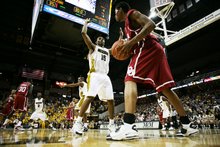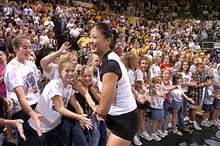I haven’t finished walking through all the different statistical categories I’ll be using yet (see what I have done so far here), but as I finish that up, I still plan on walking through the play-by-play stats of each game as they’re completed.
Which means it’s time to look at the Illinois game. What you will find below has nothing to do with what can be found in a box score—box scores are filled with beyond vital information, and everybody looks at them, but...well, everybody looks at them. There’s no point in rehashing. What I want to look at here are only things you can’t find anywhere else. So let’s get started.
Success Rate by Quarter
Instead of looking at the scores by quarter, we’ll look at Success Rates (as defined in previous stat posts). While this inevitably will match up at least partially with the scores for each quarter, this will give a better idea of who was dictating the play at the time.
Q1: Missouri 37.0%, Illinois 25.0%
Q2: Missouri 42.9%, Illinois 59.1%
Q3: Missouri 64.7%, Illinois 45.2%
Q4: Missouri 33.3%, Illinois 36.8%
Total: Missouri 42.4%, Illinois 44.0%
As you see, this suggests that Missouri controlled the play in the first quarter, while Illinois did in the 2nd. That makes sense if you watched the game, though the score by quarter shows a completely different tale. Missouri won the first quarter 7-6 and won the second quarter 16-0, even though Illinois began moving the ball quite well. What Success Rates don’t show you, of course, are the big plays. Illinois’ blocked punt, Pig Brown’s fumble return TD, Jeremy Maclin’s punt return TD, Chase Daniel’s “fumble” (yes, I’m still bitter), the Mizzou safeties’ two fourth quarter INT’s, etc. Big plays obviously define games and dictate wins and losses, but success rates give you a better idea of how a team really played...and it might be an indicator of how they’ll play in the future. We’ll see. For Mizzou’s sake, hopefully not...though this does reaffirm what the 2006 QB stats showed last week—Mizzou was fantastic in the first and third quarters, mediocre-at-best in the second and fourth.
QB Success Rate
For this, we’ll go back to a consistent criterion for my looks at data: we’ll only look at plays made when the game was within less than 17 points. Above, we looked at everything. This actually (unintentionally) removes quite a bit of Illinois’ 3rd quarter plays since they had possessions start when the game was 23-6, 30-13, 37-13, and 37-20. As for Mizzou, the only drive it took away was one at 37-27.
Remember: the QB Success Rate measures the success rate for every play in which the given QB took the snap. Even running plays that had little to nothing to do with the QB.
Missouri
Chase Daniel – 35 for 84 (41.7%)
Martin Rucker – 2 for 2 (100.0%)
Chase Patton – 0 for 1 (0.0%)
TOTAL – 37 for 87 (42.5%)
Martin Rucker for starting QB!
Illinois
Eddie McGee – 16 for 39 (41.0%)
Juice Williams – 8 for 18 (44.4%)
TOTAL – 24 for 57 (42.1%)
It should be noted that the last five plays Juice Williams ran before his injury were ‘successful’ plays. He was 3-for-13 (23.1%) before that string of success. Would that success have continued? Probably not, but it’s not like we’ll ever know for sure.
Run Success Rate
(Again, only when the game was within less than 17.)
Missouri
Tony Temple – 2 for 15 (13.3%)
Chase Daniel – 2 for 9 (22.2%)
Martin Rucker – 2 for 2 (100.0%)
Jeremy Maclin – 1 for 1 (100.0%)
TOTAL – 7 for 27 (25.9%)
UGH. Horrid. As bad as Temple’s % is, Daniel’s is almost worse. When a QB runs (and this isn’t including sacks), he really needs to be successful...otherwise the risk is too great. Ironically, he was concussed on one of his two runs that were successful.
Illinois
Rashard Mendenhall – 3 for 10 (30.0%)
Juice Williams – 3 for 5 (60.0%)
Eddie McGee – 1 for 3 (33.3%)
Daniel Dufrene – 1 for 3 (33.3%)
TOTAL – 8 for 21 (38.1%)
Illinois wasn’t very good running either, but in comparison to Mizzou they had Ladanian Tomlinson and Brad Smith in the backfield.
Receiver Success Rate
Missouri
Martin Rucker – 9 for 10 (90.0%)
Danario Alexander – 5 for 9 (55.6%)
Chase Coffman – 6 for 7 (85.7%)
Will Franklin – 3 for 4 (75.0%)
Tommy Saunders – 3 for 4 (75.0%)
Jeremy Maclin – 2 for 2 (100.0%)
Jared Perry – 1 for 1 (100.0%)
TOTAL – 29 for 37 (78.4%)
All-World TE Chmartin Ruffman with an outstanding 15-for-17 effort.
Illinois
Rejus Benn – 3 for 4 (75.0%)
Kyle Hudson – 3 for 3 (100.0%)
Jacob Willis – 2 for 3 (66.7%)
Brian Gamble – 2 for 2 (100.0%)
Rashard Mendenhall – 2 for 2 (100.0%)
Joe Morgan – 1 for 1 (100.0%)
TOTAL – 13 for 15 (86.7%)
Kind of a “quantity vs quality” dynamic here. When Illinois completed a pass, it was almost certainly successful...but in a close game, Illinois only completed 13 passes. Mizzou had a worse success rate, but they had over twice the completions (29) overall.
Line Yards
This is a concept I haven’t covered here yet. Line Yards are a way to evaluate the play by the Offensive and Defensive Lines. The general rules (as studied and tweaked by the good folks at Football Outsiders) are as follows:• For a play that resulted in negative yards, the O-line is granted 120% of the effort (i.e. a 3-yard loss would be a 3.6-yard loss for the O-line).
As you would expect, the Line Yards averages aren’t going to be all that high. This is the next thing I’m going to cover in my 2006 data pieces, so you’ll see how teams compare to each other then. For now, we will only know enough to compare Illinois to Missouri.
• For a play that resulted in a 0-4 yard gain, the O-line is granted 100%.
• For a play that resulted in a 5-10 yard gain, the O-line is granted 50% of the yards over 4 (i.e. an 8-yard gain would be a 6-yard gain for the O-line).
• For a play that resulted in a 10+ yard gain, the O-line get no extra credit—by that point, the runner is into the secondary, and the line won’t get much chance to block. Therefore (if the math in my head is correct), the most credit an O-line can get is 7.5 yards.
Line Yards – Rushing
(Again, with the game within <17>Line Yards – Passing
To me, this stat doesn’t carry as much weight as the rushing yards, though obviously a line will get significantly penalized for sacks.
Missouri: 55 attempts, 165.3 yards (2 sacks for -26 yards) (3.01 LY/pass)
Illinois: 30 attempts, 87.2 yards (1 sack for -4.8 yards) (2.91 LY/pass)
Line Yards – TOTAL
Missouri: 82 plays, 202.7 yards (2.47 LY/play)
Illinois: 51 plays, 123.4 yards (2.42 LY/play)
Defensive Success Rates
This will measure the success rates (the lower the better, since we’re still dealing with offensive ‘success’) for each player who made a tackle. I’ll only do Missouri here, unless somebody is just dying to see Illinois’. As a whole, you expect the D-Line to have the best (i.e. lowest) overall percentages, then LB’s, then secondary. If they don’t go in that order, something was funky. This makes sense, since well, the D-line starts closer to the line of scrimmage and therefore closer to the ‘success’ line.
Defensive Line
Lorenzo Williams – 1.0 tackles, 0.0 were successful (0.0%)
Stryker Sulak – 1.5 tackles, 0.5 were successful (33.3%)
Ziggy Hood – 2.5 tackles, 2.0 were successful (80.0%)
Tommy Chavis – 0.5 tackles, 0.5 were successful (100.0%)
TOTAL – 5.5 tackles, 3.0 were successful (54.5%)
Linebackers
Sean Weatherspon – 6.0 tackles, 2.5 were successful (41.7%)
Brock Christopher – 5.5 tackles, 2.5 were successful (45.5%)
Van Alexander – 1.5 tackles, 1.5 were successful (100.0%)
TOTAL – 13.0 tackles, 6.5 were successful (50.0%)
Secondary
Pig Brown – 4.5 tackles, 1.5 were successful (33.3%)
Hardy Ricks – 2.5 tackles, 1.5 were successful (60.0%)
William Moore – 4.0 tackles, 2.0 were successful (50.0%)
Darnell Terrell – 1.5 tackles, 1.5 were successful (100.0%)
Del Howard – 3.0 tackles, 3.0 were successful (100.0%)
TOTAL – 15.5 tackles, 9.5 were successful (61.3%)
It’s definitely weird when the LB’s are more successful than the D-Line, and it’s even more weird when the best overall success rate belongs to Pig Brown, the strong safety, the supposed last line of defense.
Turnover Costliness
A while back, I asked for feedback (and got none, ahem) regarding a measure of turnover costliness. Here’s the formula I discussed then:As I've been entering the play-by-plays, I came up with a pretty primitive equation that simply factors where the turnover took place (3 points if it took place between either your or your opponent's goalline and 20, 2 if it took place between either 20 and 40, 1 if it took place between the 40's) and how close the game was at the time of the turnover (2 points if within two possessions, 1 point if within 24 points, 0 if over 24 points). There's a maximum of 5 points available. If the turnover is returned for a TD, it's an automatic 5 points.
I also added...That's okay, but it still doesn't really tell the story. For instance, if you fumbled at your 45 and it was returned to your 1, that's 1 point because it took place at your 45. I guess I could simply look at resulting field position to fix that problem...but that would open up the opposite problem (you fumble at your opponent's 1, they return it to the 45...and it's only 1 point). Maybe an average of the two?
Until I come up with a better formula, however, this is the one I’m going to use. However, when more descriptive of the situation, I’ll use the resulting field position. Here’s a summary of the game’s 7 turnovers:
Illinois1 (MU 7-6, Eddie McGee fumbles at Mizzou 2, Pig Brown returns for TD) – 5
Illinois2 (MU 13-6, Eddie McGee fumbles at Mizzou 32, Pig Brown recovers) – 4
Illinois3 (MU 20-6, Duvalt fumbles kick return, Connell Davis recovers at UI 14) – 5
Missouri1 (MU 37-20, Danario Alexander fumbles exchange at Mizzou 38) – 3
Missouri2 (MU 37-27, Daniel “fumbles” at Mizzou 11, returned to Mizzou 2) – 5
Illinois4 (MU 40-34, William Moore interception at Mizzou 23) – 4
Illinois5 (MU 40-34, Pig Brown interception at Mizzou 1) – 5
Average costliness of Illinois turnover: 4.6 (23 divided by 5)
Average costliness of Mizzou turnover: 4.0 (9 divided by 2)
I guess that makes some semblance of sense. I mean, Mizzou’s turnovers were costly—they both resulted in TD’s within 10 seconds of the turnover—but Illinois’ were even more costly—two occurred at the Mizzou goalline, one was returned 100 yards for a TD, one was recovered inside the Illinois redzone, and two others stopped drives deep in Mizzou territory. Still, though...I know something better can be done with this ‘Costliness’ figure...I just don’t know what yet. Ideas?
Mizzou Statistical MVPs
Offensive: Martin Rucker – he touched the ball 12 times (twice even lining up at QB), 11 of which resulted in ‘success’ (91.7%). It’s really hard to get better than that.
Defensive: Pig Brown – duh. Not only did he have the three takeaways—including a TD and the game-clinching INT—he was also the most ‘successful’ tackler on the field (a 33.3% offensive success rate). Gary Pinkel said yesterday that he couldn’t imagine Pig Brown ever being able to play better than that...it’s maybe a weird thing for a coach to say about one of his own players, but it’s true. Playing better statistically would be damn near impossible.
So there you have it. I will now attempt to solicit more feedback. What do folks think about this? Is it interesting to anybody beyond just me? Are other stats or different formatting I should be looking at? Is there a better way to look at turnover costliness?
Thursday, September 6, 2007
Mizzou-Illinois: Beyond the Box Score
Posted by
The Boy
at
12:24 PM
![]()
Labels: Beyond the Box Score, Mizzou football
Subscribe to:
Comment Feed (RSS)






|